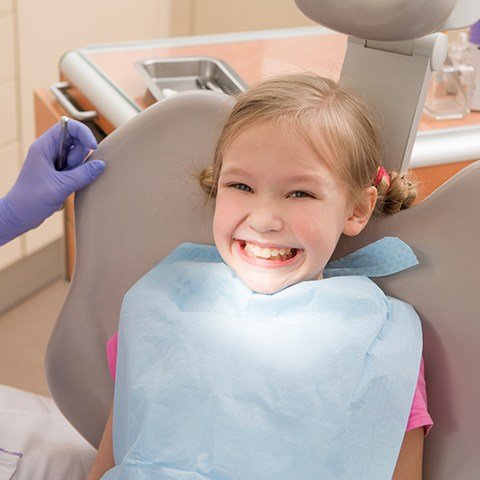
Phase 1 Orthodontics – Grayslake, IL
Early Intervention for a Lifelong Smile
Some patients as young as five or six years old may benefit from early or phase one orthodontics in Grayslake, IL. The American Association of Orthodontists recommends that all children have an exam with an orthodontist by their seventh birthday. This is the age when the first adult teeth are erupting in the mouth and developing jaw and bite issues may start to show themselves.

Why Choose Grayslake Orthodontics for Phase 1 Orthodontics?
-
Skilled Orthodontist &
Highly-Experienced Staff -
Wide Variety of
Orthodontic Appliances -
Comfortable,
Modern Care
What Kind of Issues Can
Phase 1 Orthodontics Address?

Some of the most common problems that are treated are crossbites, underbites, severe crowding, severe protrusion, very deep overbites, dental habits (such as thumb sucking, tongue thrusting, etc.), space loss due to the early loss of baby teeth, or dental eruption issues. Also, other types of problems such as missing teeth should be addressed early so the appropriate treatment can be discussed and planned early on.
What Benefits Does
Phase 1 Orthodontic Treatment Offer?

- Create room for all of the adult teeth to erupt correctly
- Reduce the need for adult tooth extraction
- Avoid tooth impaction
- Correct asymmetric jaw growth
- Address oral habits, like thumb sucking
- Improve esthetics
- Improve speech
- Avoid more difficult Phase II treatment or a compromised final result
What Treatments
are Available?

Many different types of treatment can be used to help correct early issues. Dr. Ben utilizes the best possible treatment for each case depending on the exact problem. For example, some situations only require an expander, some can be fixed with limited braces, and others can be corrected with special retainers. Combinations of these interventions can be used as well.
In some cases, extractions of baby teeth are used as a part of treatment. This is most common in cases where there is severe crowding, but there are other indications as well. Sometimes baby teeth will prevent permanent teeth from erupting, or cause teeth to erupt in the wrong place. In severe situations, this can damage the permanent teeth or compromise the health of the gums and jaw bone. This type of damage is often permanent. If an extraction is recommended, Dr. Ben will give a very thorough explanation and go over the benefits. An extraction may be done by either a general dentist, a pediatric dentist, or an oral surgeon.
What Can You Expect
from Treatment?

Phase I treatment is not designed to prevent the need for comprehensive orthodontic treatment. This does happen in some cases, but most children will need full treatment once all the permanent teeth have fully erupted. Phase I treatment is designed to eliminate significant dental and skeletal problems early on and allow normal dental and skeletal development to proceed while the remaining permanent teeth are erupting.
What Happens After
Phase 1 Treatment?

After phase I treatment, the patient will need to wear a retainer to hold their progress. Usually, these retainers are worn for about a year. As baby teeth are lost and the patient grows, the fit of the phase I retainer becomes compromised and, after about a year, the retainer is no longer useful.
It’s important to note that the goal of early treatment is not to avoid needing full braces when all of the adult teeth come in (typically around 11 to 13 years old). More often than not, comprehensive treatment is still needed to get to an acceptable and stable final result.
How Much Does Phase 1 Orthodontics Cost?

The costs of Phase I treatment are part of the overall treatment fee, so the overall cost of treatment will still be the same. Any payments for phase I treatment are applied to any future comprehensive treatment. For example, if $1800 was paid for Phase I treatment and the comprehensive fee is $5000, then the Phase II fee would be $3200. In most cases where Phase I treatment was done, comprehensive treatment tends to be less difficult to complete and shorter in duration, which is why Dr. Ben has this fee plan in place.
Phase I Orthodontics FAQs
When Does Phase I Orthodontics Take Place?
Phase I orthodontics typically begins when children are between six and nine years old, though some patients should get started even earlier than that. It is best to get your child evaluated by their seventh birthday because, at this age, the jaw and facial bones are still developing, making it possible to guide growth in a positive direction. Well-timed phase I treatment can address growth issues before they become more severe.
Getting an orthodontic evaluation is important for every child. Oftentimes, your child’s regular dentist will advise you to bring them to an orthodontist when they are around 7 years old.
How Do I Know My Child Needs Phase I Orthodontics?
You might notice that your child has bite problems, crowded or crooked teeth, thumb-sucking habits, or difficulty speaking clearly. We recommend bringing these concerns to our practice for a thorough evaluation. Dr. Ben uses advanced diagnostic tools and methods to identify issues that might benefit from early intervention. He will explain what he sees and provide recommendations tailored to your child’s needs.
Is Phase I Orthodontics Painful?
Having orthodontic appliances is more comfortable the younger you are. Younger people have greater plasticity. This means their mouths adapt to change much more readily than older people do.
However, phase I patients should expect some mild discomfort as their teeth and jaws adjust to their new orthodontic hardware. At Grayslake Orthodontics, we strive to minimize any pain by using gentle techniques and regularly monitoring progress. Most children adapt quickly. Their soreness typically fades within a day or two of each adjustment.
If your child expresses discomfort, you may choose to give them appropriate doses of over-the-counter pain medication. You can also encourage them to sip on cool water; its temperature can be soothing for sore oral tissues.
Does Phase I Orthodontics Affect Diet & Nutrition?
If your child has a removable appliance, they should take it out at mealtimes and eat as normal.
On the other hand, if they have fixed appliances, such as braces, certain foods may need to be avoided to protect the orthodontic gear and allow for consistent progress. For example, hard or sticky foods, like nuts or caramel, can damage braces or expanders. We will provide detailed dietary guidelines and offer advice on nutritious options that are safe for your child.
Can a Child’s Bite Issues Get Better on Their Own?
If Dr. Ben makes a recommendation to intervene on a child’s bite issue, it is because he does not expect that issue to resolve on its own. In some instances, bite issues may worsen with time. We can use diagnostic evaluations to determine whether waiting is appropriate in your child’s case or if phase I treatment offers significant benefits. Timely action can prevent more painful and more expensive treatment down the line.
